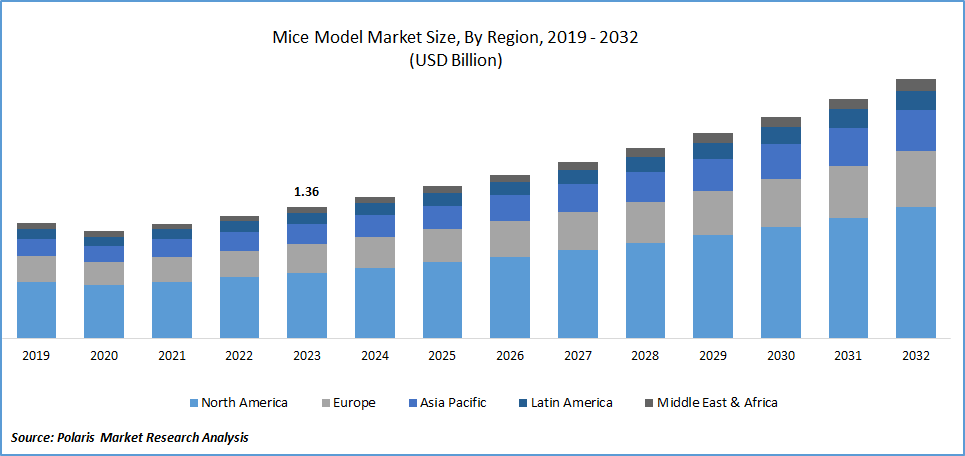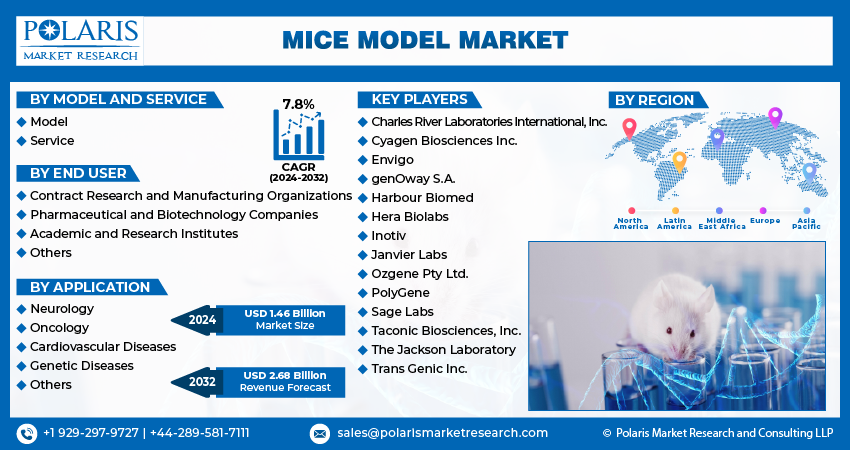
Mice Model Market Share, Size, Trends, Industry Analysis Report
By Model and Service; By End User; By Application (Neurology, Oncology, Cardiovascular Diseases, Genetic Diseases, Others); By Region; Segment Forecast, 2024 - 2032
- Published Date:Apr-2024
- Pages: 117
- Format: pdf
- Report ID: PM4830
- Base Year: 2023
- Historical Data: 2019-2022
Report Outlook
- Mice Model Market size was valued at USD 1.36 billion in 2023.
- The market is anticipated to grow from USD 1.46 billion in 2024 to USD 2.68 billion by 2032, exhibiting the CAGR of 7.8% during the forecast period.
Market Introduction
The growing emphasis on personalized medicine drives the mice model market. With advancements in genomics, medical treatments are increasingly tailored to individual patient characteristics. Mice models, particularly genetically modified strains, are used for understanding disease mechanisms and developing targeted therapies. They allow researchers to simulate human disease conditions and assess treatment efficacy in preclinical studies. Additionally, mice models facilitate the exploration of disease heterogeneity and response variability, which is crucial for personalized treatment approaches.

To Understand More About this Research:Request a Free Sample Report
In addition, companies operating in the market are entering partnerships to expand market reach and enhance offerings.
- For instance, in April 2021, InGenious Targeting Laboratory and the Shanghai Model Organisms Center (SMOC) established a collaboration, enabling Innovative Targeting Laboratory to distribute SMOC's validated off-the-shelf mouse models across Europe and North America.
Rising investments in biomedical research are also driving significant growth in the mice model market. With an increasing understanding of complex diseases, the demand for reliable animal models for research and drug development is escalating. Boosted by funding from governments, academic institutions, and pharmaceutical companies, investments in biomedical research have surged. This support enables the development of novel genetically engineered mouse models tailored to mimic human diseases more accurately, enhancing the translational relevance of preclinical studies. Advancements in gene-editing technologies like CRISPR/Cas9 have further revolutionized the creation of genetically modified mice models, enabling more precise and efficient modeling of complex diseases.
Industry Growth Drivers
- The increasing prevalence of chronic diseases is projected to spur product demand.
The rising incidence of chronic diseases fuels the mice model market. Conditions like cancer, diabetes, cardiovascular, and neurological disorders necessitate reliable animal models for research and treatment development. Mice models, especially genetically modified strains, closely mimic human genetics and physiology, aiding in disease understanding and therapy evaluation. They facilitate preclinical studies, biomarker identification, and personalized medicine research. With personalized treatment approaches gaining prominence, mice models are pivotal for studying disease variations and targeted therapy development.
- Advances in genomic technologies are expected to drive mice model market growth.
Advances in genomic technologies are driving significant the mice model market growth. Researchers increasingly rely on mice models to study human diseases and develop new therapies, and cutting-edge genomic tools enhance precision and efficiency. Techniques like CRISPR/Cas9 gene editing, next-generation sequencing (NGS), and genome-wide association studies (GWAS) enable the creation of genetically modified mice models with high speed and accuracy. These technologies offer precise manipulation and analysis of disease-associated genes, providing valuable insights into disease mechanisms and potential treatments. Additionally, genomic advancements enable personalized mouse models that mimic human genetic diversity, enhancing translational research and preclinical testing of therapeutics.

Industry Challenges
- Regulatory restrictions and compliance are likely to impede the mice model market growth.
Regulatory restrictions and compliance present significant hurdles in the mice model market. Stringent regulations surrounding animal welfare and research ethics govern the use of mice models in scientific experiments. Researchers must adhere to strict guidelines for housing, care, and experimentation, which vary across regions. Obtaining ethical approval for experiments involving mice models is often time-consuming and costly, leading to delays and increased expenses. Moreover, the trend towards reducing animal experimentation and promoting alternative methods challenges the market's growth. Researchers and pharmaceutical firms encounter obstacles in accessing and utilizing mice models for preclinical studies, potentially impeding progress in biomedical research and drug development.
Report Segmentation
The mice model market analysis is primarily segmented based on model and service, end user, application, and region.
|
By Model and Service |
By End User |
By Application |
By Region |
|
|
|
|
To Understand the Scope of this Report:Speak to Analyst
By Model and Service Analysis
- The model segment held a significant mice model market share in 2023
The model segment held a significant mice model market share in 2023 due to its versatile applications, including disease modeling, drug discovery, and toxicology studies. Offering customization options and various species choices, it caters to diverse research needs. Technological advancements such as genetically modified models and advanced imaging techniques further drive revenue growth. Additionally, adherence to regulatory standards and ethical guidelines ensures compliance and instills confidence among researchers, bolstering revenue in the market.
By End User Analysis
- The pharmaceutical and biotechnology companies segment held a significant mice model market share in 2023
The pharmaceutical and biotechnology companies segment held a significant mice model market share in 2023. These firms extensively rely on mice models for drug development and testing. Mice models play a vital role in disease modeling, enabling researchers to replicate human diseases and study their mechanisms, facilitating therapeutic development. Moreover, they are crucial for evaluating drug safety and efficacy, aiding in the identification of promising compounds for further development. With the rising emphasis on personalized medicine, these companies use mouse models to study individual treatment responses and tailor therapies. Regulatory compliance requirements also drive demand for mice models in preclinical testing, further boosting revenue in this segment.
By Application Analysis
- The oncology segment held a significant mice model market share in 2023
The oncology segment held a significant mice model market share in 2023. The global prevalence of cancer fuels demand for specialized mice models tailored to cancer research. With cancer's complexity, diverse subtypes, and mechanisms, a variety of mouse models are necessary for accurate representation in research. These models play a critical role in the preclinical testing of potential cancer therapies, contributing to drug development pipelines and revenue in the oncology segment. Furthermore, the trend of personalized medicine in oncology necessitates robust mouse models to study patient-specific tumor responses, driving further demand and revenue. Advancements in genetic engineering and tumor modeling techniques enhance the sophistication and relevance of mice models in oncology research, further propelling revenue growth.

Regional Insights
- North America dominated the global market in 2023
North America dominated the global market in 2023 due to its advanced research infrastructure, including prestigious universities, research institutions, and pharmaceutical companies. Leading firms heavily invest in mouse models for drug discovery and preclinical testing. Substantial government funding and favorable regulatory frameworks further bolster the region's position. Technological advancements like CRISPR/Cas9 enhance the precision of mouse models for disease research. The high disease burden and significant healthcare spending drive demand for mouse models in therapeutic development.
The demand from the Asia-Pacific region is expected to increase during the mice model market forecast period. Biomedical research is rapidly expanding in the region, propelled by increased healthcare infrastructure investment, government funding, and a growing pharmaceutical and biotechnology industry. Additionally, the rising prevalence of chronic diseases drives demand for mice models in disease modeling and drug discovery. The pharmaceutical sector is experiencing substantial growth, fueled by rising healthcare expenditure and demand for innovative therapeutics, further boosting the need for mice models in drug development. Collaborations between research institutions and pharmaceutical companies drive innovation, fostering mice model adoption in Asia-Pacific.

Key Market Players & Competitive Insights
The mice model market involves numerous entities, and the expected arrival of new contenders is poised to intensify competition. Leading market players continually enhance their technologies to maintain a competitive advantage, emphasizing efficacy, reliability, and safety. These firms prioritize strategic endeavors like establishing partnerships, improving product ranges, and participating in collaborative ventures. They aim to outperform competitors in the industry, securing a significant mice model market share.
Some of the major players operating in the global mice model market include:
- Charles River Laboratories International, Inc.
- Cyagen Biosciences Inc.
- Envigo
- genOway S.A.
- Harbour Biomed
- Hera Biolabs
- Inotiv
- Janvier Labs
- Ozgene Pty Ltd.
- PolyGene
- Sage Labs
- Taconic Biosciences, Inc.
- The Jackson Laboratory
- Trans Genic Inc.
Recent Developments
- In December 2022, Biocytogen introduced its latest innovation, the RenNano platform, offering a fully human heavy-chain antibody solution. RenNano joins the existing RenMice family alongside RenMabT and RenLite. These three platforms collectively enable Biocytogen to expedite the discovery and advancement of fully human monoclonal antibodies, as well as bispecific/multispecific antibodies and single-domain antibodies, streamlining the development process.
- In September 2023, Olink Holding AB unveiled its offering, the Olink Target 48 Mouse Cytokine Panel, a thoroughly validated multiplexed protein panel. This innovative panel provides a comprehensive insight into the murine immune system, facilitating in-depth disease modeling, longitudinal studies, and translational research endeavors.
- In January 2020, Taconic Biosciences, a prominent global supplier of animal models for drug discovery, broadened its immuno-oncology portfolio by introducing the new B2m-NOG mouse model.
Report Coverage
The mice model market report emphasizes key regions across the globe to help users better understand the product. It also provides market insights into recent developments and trends and analyzes the technologies that are gaining traction around the globe. Furthermore, the report covers an in-depth qualitative analysis of various paradigm shifts associated with the transformation of these solutions.
The report provides a detailed analysis of the market while focusing on various key aspects, such as competitive analysis, models and services, end users, and applications and their futuristic growth opportunities.
Mice Model Market Report Scope
|
Report Attributes |
Details |
|
Market size value in 2024 |
USD 1.46 billion |
|
Revenue Forecast in 2032 |
USD 2.68 billion |
|
CAGR |
7.8% from 2024 – 2032 |
|
Base year |
2023 |
|
Historical data |
2019 – 2022 |
|
Forecast period |
2024 – 2032 |
|
Quantitative units |
Revenue in USD billion and CAGR from 2024 to 2032 |
|
Segments Covered |
|
|
Regional scope |
|
|
Competitive Landscape |
|
|
Report Format |
|
|
Customization |
Report customization as per your requirements with respect to countries, regions, and segmentation. |
FAQ's
Mice Model Market report covering key segments are model and service, end user, application, and region.
Mice Model Market Size Worth $2.68 Billion By 2032
Mice Model Market exhibiting the CAGR of 7.8% during the forecast period.
North America is leading the global market
The key driving factors in Mice Model Market are advances in genomic technologies are expected to drive mice model market growth
